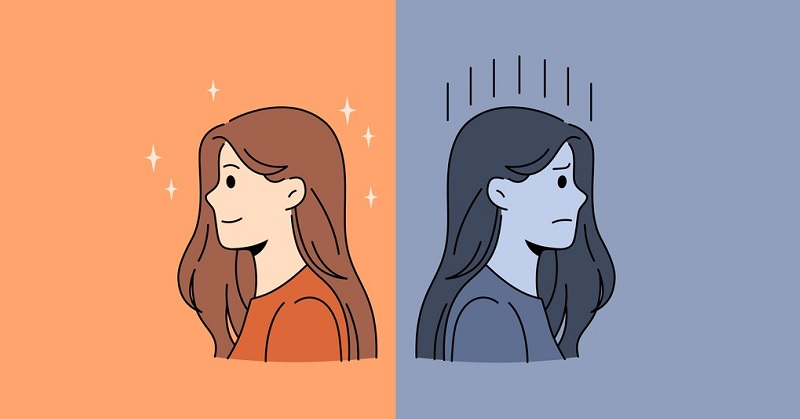All-or-nothing thinking is a type of cognitive distortion. A cognitive distortion is a mental process in which a person defaults to a specific way of thinking or assumption out of habit.
This reaction is typically negative and causes significant problems for the person experiencing it. Thus, cognitive distortions can play a significant role in the quality of one’s thoughts and emotional health.
It’s difficult to be positive and happy when your brain just defaults to all bad things when it runs across them. Furthermore, it can be impossible to accomplish long-term goals if minor hiccups can cause the person to think they cannot do it.
The good news is that this common cognitive distortion can be changed with some self-awareness and work.
Speak to an accredited and experienced therapist to help you tackle your all-or-nothing thinking. You may want to try speaking to one via BetterHelp.com for quality care at its most convenient.
What is all-or-nothing thinking?
A person who experiences all-or-nothing thinking is reacting in two extremes; either everything is great, or everything is not. If you’re not a success, then you’re a failure. If you’re not good, then you’re bad. If you’re not perfect, then you’re an unsalvageable mess.
There are no shades of gray in black or white thinking. That’s a problem because most of life exists in shades of gray. Nothing is ever perfect or unsalvageable, totally good or bad, complete success or failure. As a result, people who experience all-or-nothing thinking have difficulty bringing positive and negative perceptions together to consider the whole.
It’s even worse when you apply this method of thinking to people who are generally some mix of everything. Sometimes they’re good, sometimes they’re not. Sometimes they do not do good things because they feel it is their best course of action.
People will mess up, make bad decisions, and require forgiveness for those bad decisions. And sometimes, the person that will need that grace is you, though you may not be able to extend it to yourself if you see yourself as bad because you weren’t good.
You may also hear all-or-nothing thinking as splitting, polarized, or black-and-white thinking. All of these terms point to the same cognitive distortion.
Examples of all-or-nothing thinking.
It’s helpful to look at some examples to understand how this cognitive distortion works.
Example 1:
Mark asks his husband, Geoff, to stop at the store to pick up a particular item for dinner. Geoff makes the stop but ends up buying the wrong item without realizing it. He gets home with the item, and Mark points out that it’s incorrect. Geoff’s mind immediately jumps to thinking, “I can’t do anything right. I’m worthless. Mark will leave me because I can’t even do something as simple as buying the right item from the grocery store.”
In this example, Geoff’s mind is immediately dragging him down an extreme path over something that is a minor mistake. Assuming Mark is a healthy person himself, he might be a little annoyed with what happened or not care at all. Instead, Geoff’s mistake causes him to talk himself down to convince himself that he is not a good partner or person because of that simple mistake.
That, in turn, may cause Geoff to inadvertently cause problems for himself where there don’t need to be any. Geoff isn’t a bad person because he made a mistake. And Mark isn’t leaving him over such a minor mistake unless their relationship is already broken.
Example 2:
Carrie hasn’t spoken to her best friend in a few days. Normally, the two would text and share memes with each other off and on all day. This behavior change is upsetting to Carrie because she doesn’t know why her best friend would just drop off like that. Was it something she did? Something she said? It must be something she said or did because her friend wouldn’t drop off like that for no reason. Why am I such a bad person? Why do I mess up all of my relationships? My best friend probably hates me now.
In this example, Carrie jumps to an unreasonable conclusion that may end her friendship with her best friend if she follows through on the associated thoughts. She may isolate herself or overload her best friend because she is so worried, scared, and beating herself up over it.
The reasonable solution is not to jump to conclusions and give her best friend a call. It may be as simple as the best friend getting swamped with work and not leaving her much time.
Example 3:
Cole is on a diet to try to lose weight and get healthier. At a work function, they have a dessert table with some mighty good-looking cookies. He snags a few, eats them, and immediately feels terrible about his choice. Surely, he’s not strong enough to see this diet through to success. There’s no way he can change his eating habits and live a healthier life when he can’t even resist the temptation of a couple of cookies. Why bother trying?
In this example, Cole is jumping straight to a catastrophic end to his dieting because he feels his minor slip automatically unmakes all the work he’s put in. Though he did snag a couple of delicious cookies, it’s not the end of the world. No one’s ever 100% perfect at anything they do. And many people on diets still choose to have a cheat meal or treat once in a while.
The solution, which may not be obvious to Cole in his moment of catastrophizing, is just to start sticking with his diet again. A few cookies don’t mean anything in the major scheme of things.
What causes all-or-nothing thinking?
All-or-nothing thinking is often the result of anxiety or other mental health problems. The nature of anxiety can cause the person to automatically jump from extreme to extreme. Either everything is all good and calm, or everything is all wrong and chaotic.
PTSD, Bipolar Disorder, and depression may all also cause this thinking. It is a common cognitive distortion for people with Borderline Personality Disorder to experience.
A cognitive distortion isn’t just limited to mental illness, though. Sometimes people can fall into the habit because of the stresses and struggles they are having in their life. It’s easy to slip into a habit of thinking that the next thing you try isn’t going to go right because you’ve been struggling with other things.
Curbing All-or-Nothing Thinking
In many cases, this habit can be curbed with therapy and some additional self-work. Unfortunately, changing this thought process may require more comprehensive treatment for people with mental illness. But you can start pushing for some changes in your thinking with the following practices.
1. You are not your mistakes.
Remind yourself that everyone makes mistakes. Everyone. You’re allowed to make mistakes and still be seen as a valuable person. Other people may tell you otherwise, but typically those people aren’t all that healthy themselves. So, no. What matters is how you talk to yourself about the things you’ll experience in your life. Attempt to be kinder to yourself by softening your language and reframing it.
“I made a mistake, and that’s okay. I can do better next time.”
“I can fix what I did and try to make it up to the other person.”
These softer sentences still acknowledge negative things that might have happened but balance them with good points that can help you fix those problems.
2. Look for the gray areas of life.
Life has many gray areas. Look for them in easy-to-find places. A good place to look is people who have attained notoriety or fame. For example, Dr. Martin Luther King, Jr. was a staunch civil rights activist. He put himself in the line of fire to improve the lives of minorities and the oppressed. But unfortunately, Dr. King was also a serial adulterer who cheated on his wife multiple times.
One can look at Dr. King and try to define him as one or the other. He was a civil rights activist who did a lot of good for many people! But, on the other hand, he was a serial adulterer and hurt someone he loved and who loved him!
But therein is the gray area. He wasn’t one or the other. He was both. And neither side dismisses the other side of the coin. In reality, Dr. King was just a man like the rest of us. But that’s also why people say to never meet your heroes. You may find that they are just people too, and they may be deeply flawed behind the reason that you love them.
3. Challenge your all-or-nothing thinking.
One way to challenge your all-or-nothing thinking is to ask more questions about your thought processes. A cognitive distortion is a knee-jerk reaction to an event. It’s something your brain is going to immediately kick out in response before actually having time to think about what happened.
Think of it like brushing a hot stove. You brush the hot stove and then pull away from it. You don’t sit there and contemplate, “Hm. Is the stove hot? I bet the stove’s hot. Oh, look, the stove’s hot, and my hand is burned. I should pull my hand away from the stove. I’m pulling my hand away from the stove now.”
No, it’s an immediate response. Ouch, hot, pull away. You may not always be able to stop that initial all-or-nothing mental response. Still, you can avoid acting on it by dissecting it before you act.
Ask questions like:
– Am I leaping to a conclusion?
– Are there any other explanations?
– Is my conclusion absolutely negative or positive?
– Are my thoughts realistic?
– Am I ignoring progress?
– Am I being too hard on myself or someone else?
– Is there another way to interpret this?
4. Embrace the idea of partial success.
In Cognitive Behavioral Therapy, there is a practice to combat all-or-nothing thinking focused on partial successes. Many people with all-or-nothing thinking strictly define activities as either success or failure. And if they don’t feel they can succeed, they assume they will fail. However, that’s not a good or healthy way to evaluate your efforts.
The problem is that no one starts off good at a thing. Sure, some people are talented at things initially, but that talent means nothing without a lot of work to hone it. You can get good at anything you’re willing to practice, but you must be willing to not be good at it at first.
Try not to define your efforts in the black-and-white terms of success or failure. Instead, look at your successes as smaller steps on the greater paths toward something better. And it may sound cheesy, but failure doesn’t have to be the end. Failure, for many, is a learning experience that tells them what doesn’t work. Okay, things didn’t work out. Why didn’t they work out? What can you do differently? Can you pivot?
Pivoting is a strategy that works for many people. It’s pretty common in business. For example, a business owner sets out to do lawn care and landscaping. They may find that most customers hire them for landscaping instead of lawn care. So they pivot and drop lawn care as a service, focusing on landscaping and making much more money by leaning into what they’re finding success with.
A failure often doesn’t need to be an end. Instead, it can be the start of a new beginning.
5. Accept that two extremes can exist at once.
To combat all-or-nothing thinking, you can embrace all-and-nothing thinking instead. In essence, this means to accept that two things that are polar opposites of each other can coexist.
Here’s an example to illustrate this point:
Many creative people want to ride their wave of inspiration and creativity when it strikes them. Unfortunately, that’s not how many creative people can make a living. After all, you either work or don’t get paid for many creatives. You can’t sit around and wait for inspiration to strike so you can create. Instead, those creatives adhere to a schedule much like anyone working a 9-to-5 would.
They have a schedule and structure to work within, and there’s nothing wrong with that. However, some creatives would argue that it goes against the spirit of creativity and inspiration. The problem is that these creatives also waste a lot of time. What if you’re not inspired for weeks or months before you create again?
But let’s make it a small example. Let’s say it takes two weeks for the inspiration-driven creative to find something to be inspired by. They then spend 12 hours creating it. Are they going to progress like the person who sits down 5 or more days a week and creates for a couple hours a day? No. The person putting in regular work is going to progress faster. And there’s a big secret in that too.
Actually doing the work provides inspiration of its own. It allows you to find different angles, subjects, and interests that you may not have been able to see until you’re in the weeds of the work, where you can see the gaps.
In this case, creativity and structure can simultaneously exist. Similarly…
You can be upset by someone and still love them. You can love your job but find it exhausting and frustrating. It doesn’t have to be one or the other.
Final thoughts on all-or-nothing thinking.
Cognitive distortions like all-or-nothing thinking are more common than you may realize. The truth is that you may be able to stop your brain from jumping to these conclusions. You can also develop healthier habits to not act on them when it happens. Often, the way we think starts to formulate in childhood. People with rougher backgrounds may experience this cognitive distortion due to a survival mechanism they need to survive. Thus, it became a habit.
Still, you can make a choice on whether or not to act on this cognitive distortion. A Cognitive Behavioral Therapist should be able to help you adjust these thoughts and actions.
Still not sure how to stop all-or-nothing thinking?
Speak to a therapist to help you get a handle on things. Why? Because they are trained to help people in situations like yours. They can help you to manage your thought processes and offer tailored advice for your specific needs.
BetterHelp.com is a website where you can connect with a therapist via phone, video, or instant message.
While you may try to work through this yourself, it may be a bigger issue than self-help can address. And if it is affecting your mental well-being, relationships, or life in general, it is a significant thing that needs to be resolved.
Too many people try to muddle through and do their best to overcome issues that they never really get to grips with. If it’s at all possible in your circumstances, therapy is 100% the best way forward.
Here’s that link again if you’d like to learn more about the service BetterHelp.com provide and the process of getting started.
You may also like:











